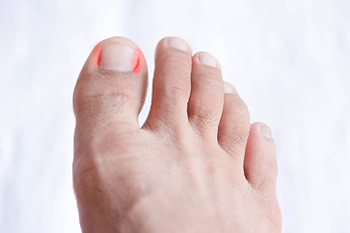How to Know if You Have an Ingrown Toenail

Recognizing an ingrown toenail early is important for timely treatment and prevention of complications. This condition occurs when the edge of a toenail grows into the surrounding skin, leading to inflammation, pain, and potential infection. Common causes of an ingrown toenail include improper nail trimming, wearing tight footwear, or genetic predisposition. Symptoms of an ingrown toenail can consist of redness, swelling, and tenderness along the nail border. In severe cases, pus or drainage may occur. Diagnosis typically involves a physical examination by a podiatrist. Treatment options include remedies like warm soaks and gentle nail trimming. A podiatrist also may offer treatment such as lifting the nail edge or surgical removal. If you have an ingrown toenail, it is suggested that you schedule an appointment with a podiatrist to prevent symptoms from worsening and obtain correct treatment.
Ingrown toenails may initially present themselves as a minor discomfort, but they may progress into an infection in the skin without proper treatment. For more information about ingrown toenails, contact Anthony Ricciardi Jr., DPM of Foot & Ankle Specialists of Nevada. Our Doctor can provide the care you need to keep you pain-free and on your feet.
Ingrown Toenails
Ingrown toenails are caused when the corner or side of a toenail grows into the soft flesh surrounding it. They often result in redness, swelling, pain, and in some cases, infection. This condition typically affects the big toe and may recur if it is not treated properly.
Causes
- Improper toenail trimming
- Genetics
- Improper shoe fitting
- Injury from pedicures or nail picking
- Abnormal gait
- Poor hygiene
You are more likely to develop an ingrown toenail if you are obese, have diabetes, arthritis, or have any fungal infection in your nails. Additionally, people who have foot or toe deformities are at a higher risk of developing an ingrown toenail.
Symptoms
Some symptoms of ingrown toenails are redness, swelling, and pain. In rare cases, there may be a yellowish drainage coming from the nail.
Treatment
Ignoring an ingrown toenail can have serious complications. Infections of the nail border can progress to a deeper soft-tissue infection, which can then turn into a bone infection. You should always speak with your podiatrist if you suspect you have an ingrown toenail, especially if you have diabetes or poor circulation.
If you have any questions, please feel free to contact our office located in Las Vegas, Nevada . We offer the newest diagnostic and treatment technologies for all your foot care needs.
